Colin Rowe: Piazza Augusto Imperatore (1995)
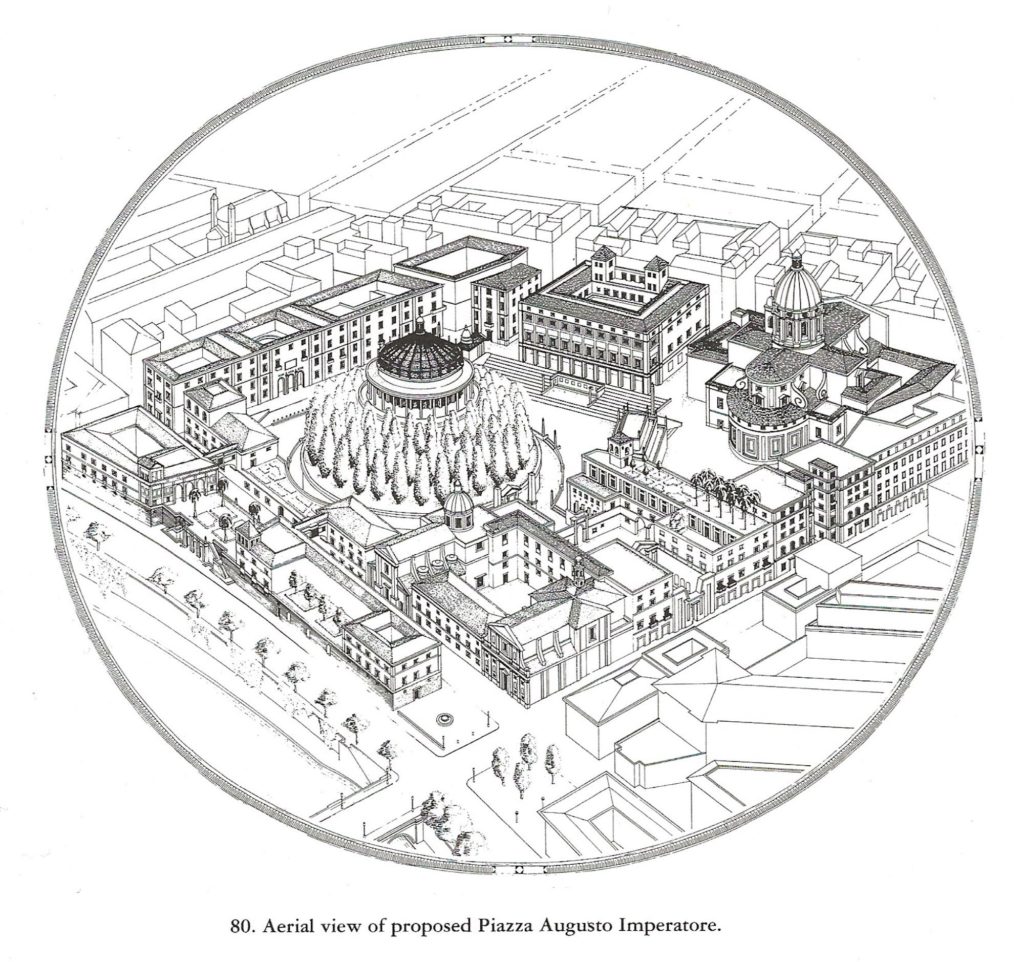
Rome shall become such as to amaze the peoples of the world: vast, well ordered, powerful as in the days of Augustus. You shall relieve the old oak of growths that cling to it. You shall clear the area around the Theater of Marcellus, the Augusteum, the Capitol, the Pantheon. All that sprang up in the ages of decadence shall vanish. The millenary monuments of our history shall stand out as giants in solitary splendour.
– Benito Mussolini, 1926
And he was almost as good – or as bad – as his words.
Divert the canals to flood the cellars of the museums. Let the glorious canvases swim ashore. The picks and the hammers! Undermine the foundations of venerable towns.
This is not Mussolini although it almost might have been. Instead it is the voice of Milanese Futurism; and it may permit the intrusion of yet a further quotation:
Prophets and forerunners of the great Italy of today, we Futurists are happy to salute in our not yet forty year old Prime Minister a marvellous Futurist temperament.
From Marinetti to early Mussolini is, of course, but a step, and there is surely a strand of early Fascist rhetoric–that exaltation of dynamism and violence–which may be seen to disclose its only too likely origins in Futurist Milan. But those Milanese Futurists, who imagined themselves to be on ‘the promontory of the centuries,’ to be the cutting edge of continuous becoming, of never to be impeded change, who could conceive of both life and the city as an unceasing frenzy of demolition and construction, whose delirium contributed so much to the psychological set of Modern architecture; did they also contribute something of their frenzy to the psychological set of Benito Mussolini? And, with significant modification, the answer must surely be that they did. However, as regards buildings, in Rome the message from Milan could only become somewhat changed. For, if in Milan it was history in toto which was to be seen as a contaminant, in Rome Mussolini could only be more selective. For, after all, in Rome there were those ‘millenary monuments’ only waiting decisive action so that they could ‘stand out as giants in solitary splendour.’ A bad history and a glorious history, respectively the Rome of the Papacy and the Rome of the Empire, such was the problem of Rome as Mussolini seems to have perceived it; and, while the relics of Imperial Rome were waiting to be exalted, then–inevitably–the huge residues of the so many years in between were, very largely, to be considered as dismissible.
Futurist fervour curiously compounded with whatever might be the characteristic zeal of the classical archaeologist, the determination to reveal every trace of antiquity whatever the cost might be. Such seems to have been the state of mind which inspired Mussolini’s literally devastating demolitions, his sventramenti, of which that made to facilitate the route of the Via dei Fori Imperiali was emphatically the most extreme. Almost it fulfilled the Futurist ambition to ‘undermine the foundations of venerable towns.’ Inaugurated in 1932, extending from the Piazza Venezia to the Colosseum, for the purpose of this indifferent avenue a whole community was wiped out–eleven existing streets with all the accessory apparatus of houses, palaces, and churches. Almost it was Rome’s rather belated response to what had been Milan’s most extravagant demands; and, by comparison, the site to which we were asked to address ourselves, the Piazza Augusto Imperatore, is a very modest little sventramento indeed.
In his book La Piazza del Popolo (Rome: Officina, 1974) Giorgio Ciucci emphasizes that, by the early eighteenth century, the northern section of papal Rome had come to involve a triangulation of three highly spectacular events: the Piazza del Popolo itself’ the Scala di Spagna; and, on the river, the Porto di Ripetta. These were the points of orientation, the places of destination which an air view would have disclosed; and so they survived until the late nineteenth century when the Porto di Ripetta was demolished for the building of a no doubt necessary bridge; and a result of this was to diminish the cogency of the entire area. Simply one of the corners of the triangle had been eliminated.
A conceptual problem no doubt; but also not without perceptual implications. For, if one stands at the obelisk in Piazza del Popolo and looks down the three streets which present themselves, one is compelled to recognize that the Via del Babuino and the Via di Ripetta were never equal. Almost certainly Via del Babuino has always been preferred and, almost certainly, Via di Ripetta has always been avoided. Via del Babuino leads to the allure of Piazza di Spagna; and, after the destruction of its romantically baroque little port, Via di Ripetta can only lead to not very much.
And now to approach the Mausoleum itself. A circular building, too big to be interpreted as a mere tempietto, too small ever to be thought of as a rival to Castel Sant’Angelo, during the course of its long history it has been at different times a fortress, a platform supporting an elevated garden, a bull ring, and–earlier in this century–a concert hall, all this before it was stripped of its accretions to become the difficult object, the restored ruin which it is today.
This then is the Augusteo; and, as of now, it is not exactly a highly gratifying sight. Located in what appears to be a left-over space, it has required excavation down to the original level in order properly to disclose it; and, further to this, it stands in compromising proximity (though at a different level) to that large glass box built in the late 1930s, at the expense of further degradation of the Via di Ripetta, to permit a display of the Ara Pacis.
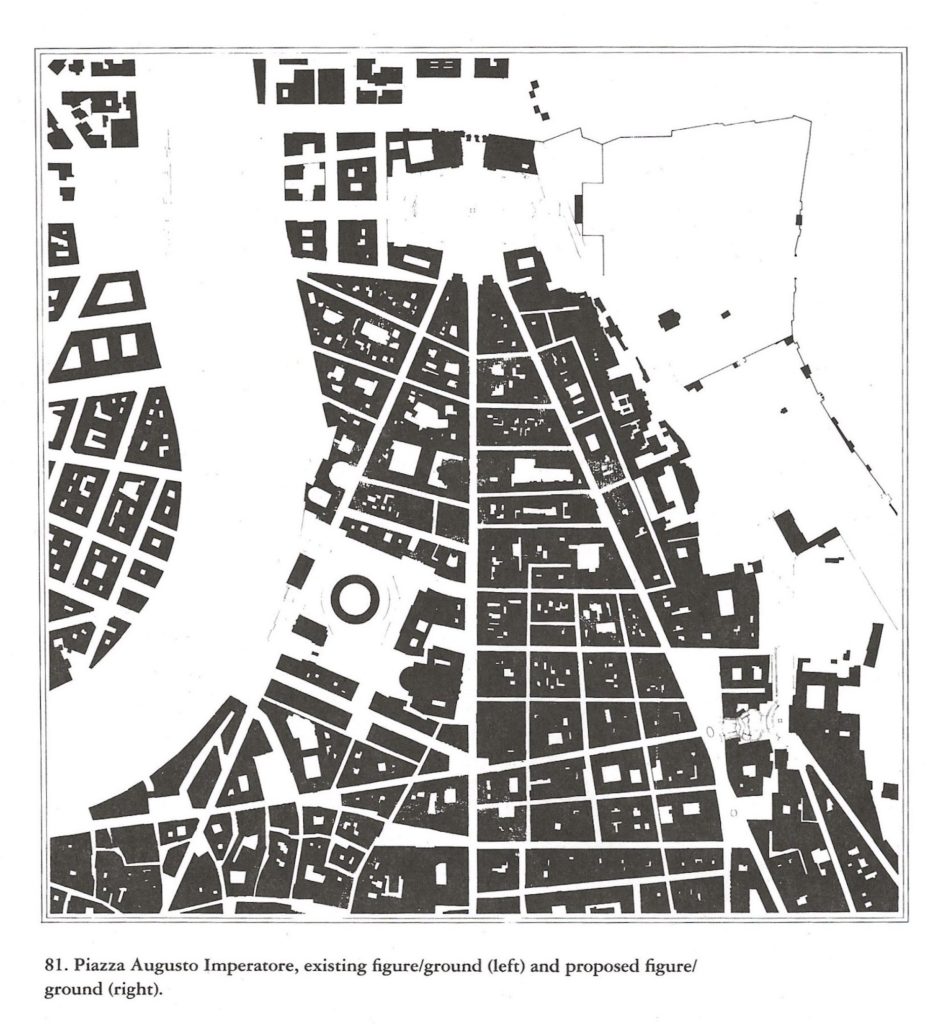
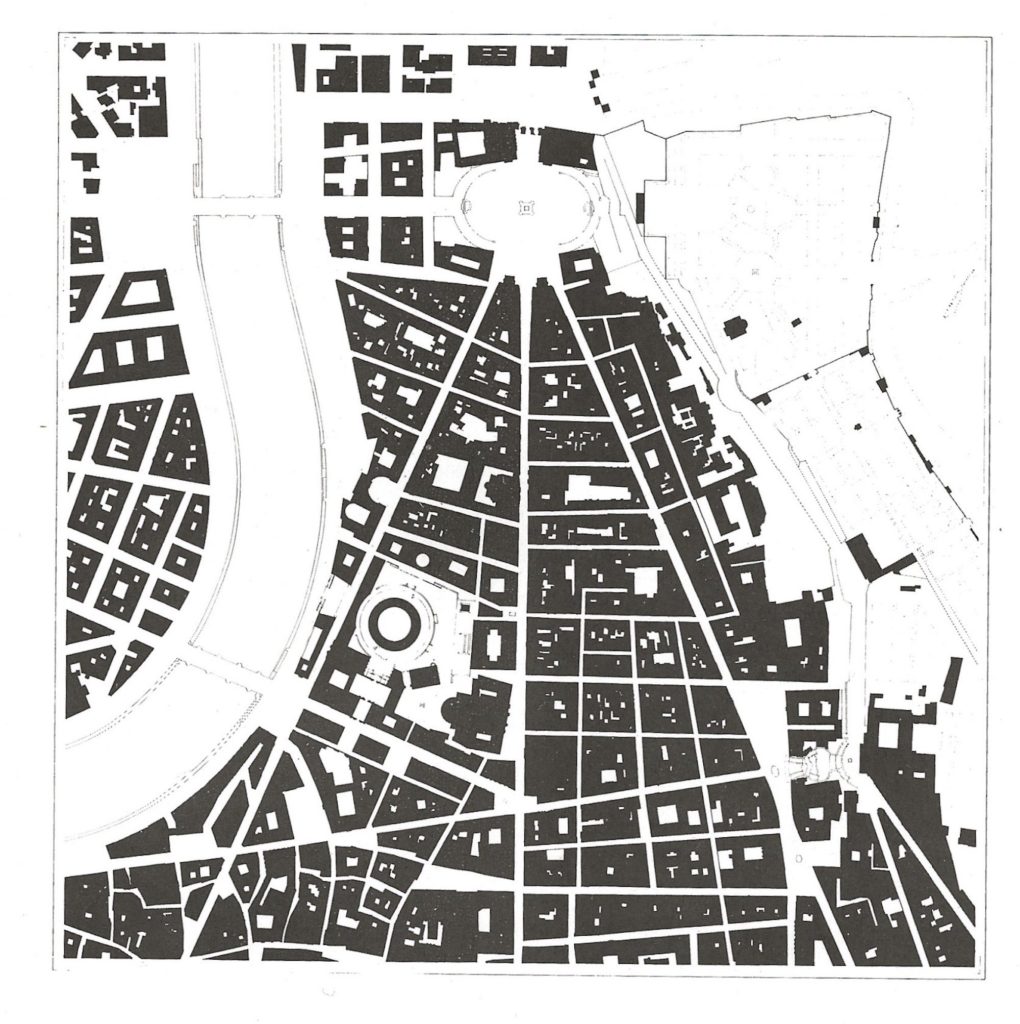
And so much is a brief summary of the problems with which we were confronted: problems of level; problems of access and animations; and problems of alleviating the disruption of the urban fabric.
So, to the west, we were concerned with a restoration of Via di Ripetta; and, for this purpose, we removed the Ara Pacis to a position adjacent to the splendid apse of San Carlo al Corso. And, then, we proceeded to reline this much-abused street with an apparatus of buildings and terraces–buildings connected at the upper level by bridges and terraces commanding views of the river with limited return views from across the river of the Augusteo.
Then, to the south we propose two entrances: one from the existing piazza on Via Tomacelli which would lead to what we call the Piazzetta Sen Carlone; and the other to a new piazza which would lead to the entrance of the Augusteo.
Then, to the north, we propose a long building (in that area, where San Giacomo degli Incurabili is so close, a building can only be long) which might house apartments or offices; and, to the west and next door to San Carlo al Corso, we suggest a grand hotel, which we call the Albergo Borromeo, the lobbies of which would lead to a caffè overlooking the Augusteo and its surrounding space.
The Augusto itself we have surrounded with circles of cypresses and, perhaps with insufficient reverence, we think of it as becoming, up top, an aviary and, down below, an aquarium.
These were the major moves; but in the process of drawing all this up there was one unexpected little mishap. I failed to stop the group before they drew their own, highly imaginary plan of the mausoleum!
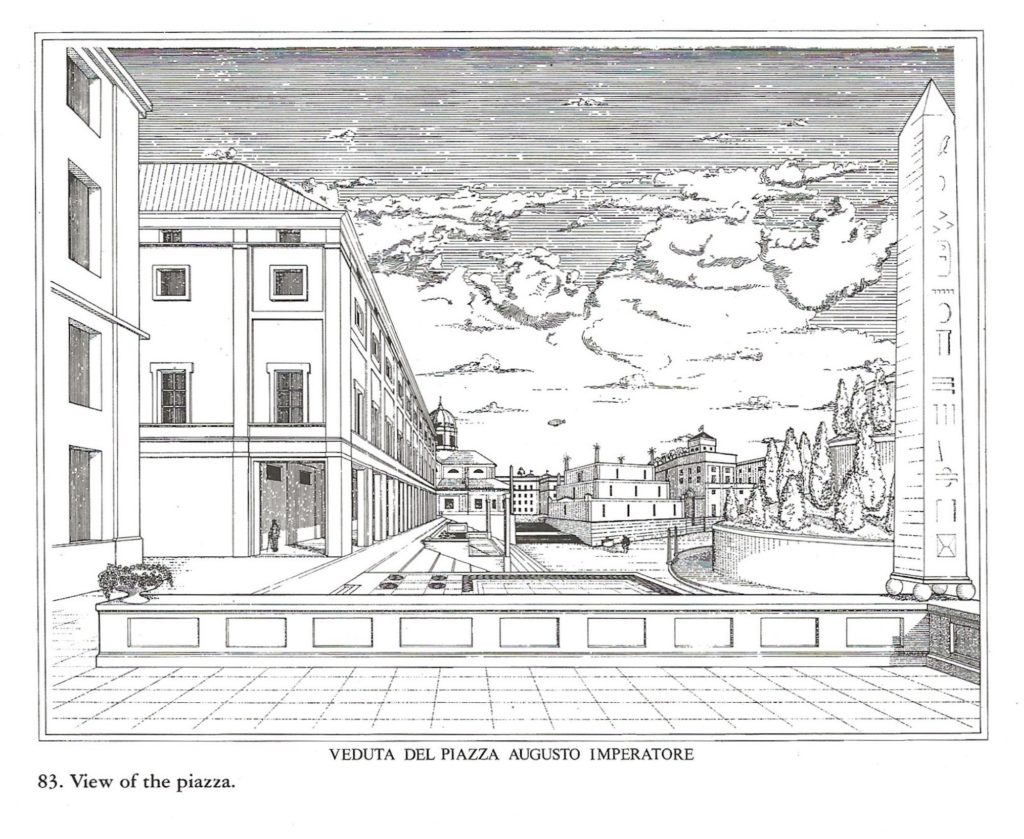
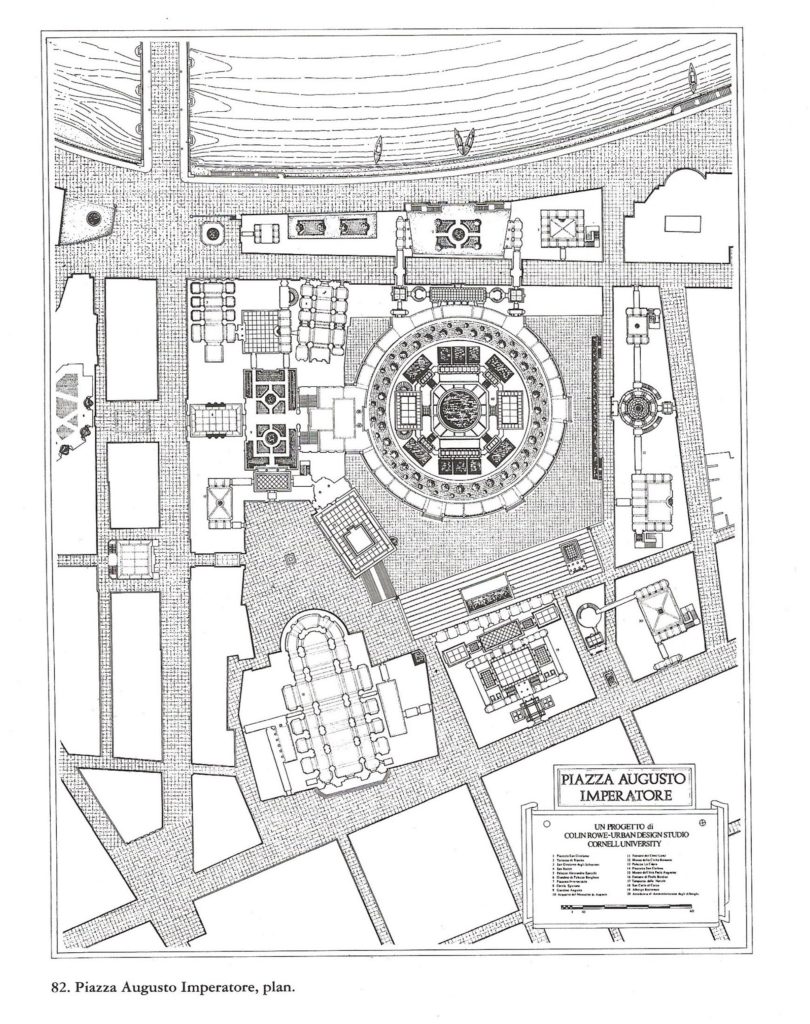
This text was written in 1995 as a retrospective response to Rowe’s contribution to the 1987 Milan Triennale, produced alongside Matthew Bell, Robert Goodill, Kevin Hinders, Brian Kelly, and Cheryl O’Neil, with Paolo Berdini as occasional critic. The scheme for the area around the Augusteo was one of nine projects for nine cities (Nove Progetti per Nove Città), a logical continuation from Roma Interrotta (1978) and, as Rowe recalled, it was ‘quite vital for the entertainment of those students whom I met in 1980–81 while teaching for the University of Notre Dame in Rome and who, after graduation, had followed me to Cornell.’
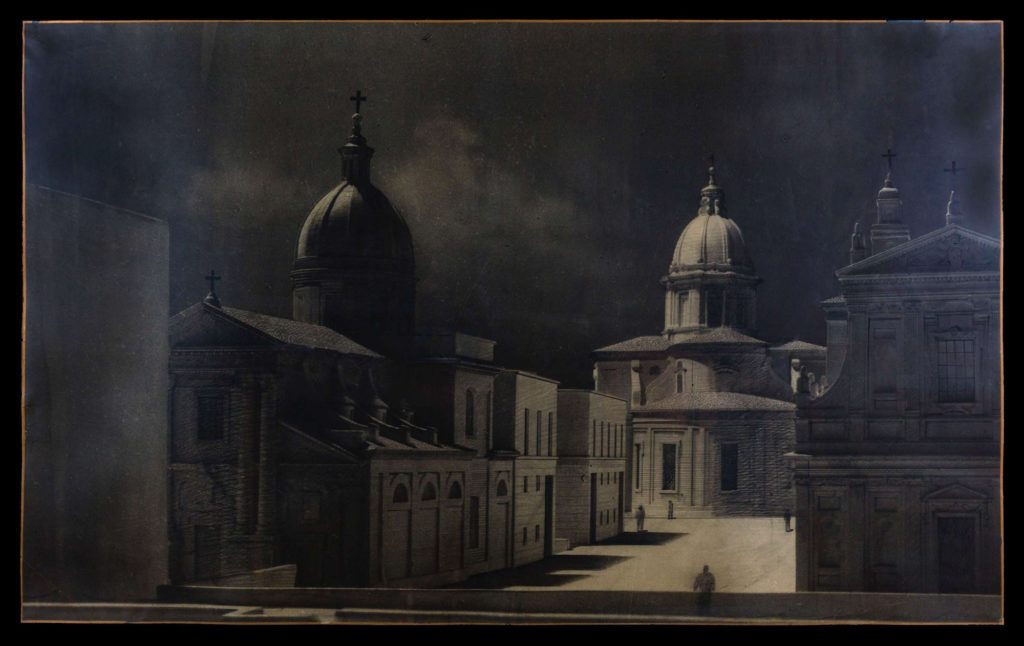
Vittorio Morpurgo, a favourite of Mussolini, was entrusted with designing the Piazza Augusto Imperatore in the mid-1930s. This drawing shows a view through an excised corridor between San Rocco and San Girolamo Dei Croati, with the Basilica dei Santi Ambrogio e Carlo al Corso at the far side of the piazza. Curiously, it does not show the Mausoleum of Augustus, the antique centrepiece of the piazza. Read John David Rhodes’ text on Morpurgo’s drawing by following the link below.
